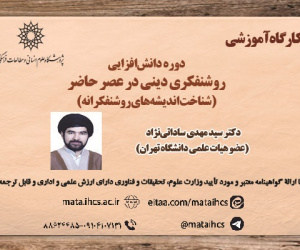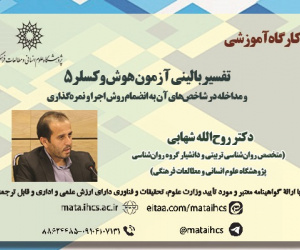اثربخشی آموزش ذهن دلسوز بر تحمل پریشانی، جرئتمندی، خوددلسوزی و همدلی نوجوانان (مقاله علمی وزارت علوم)
درجه علمی: نشریه علمی (وزارت علوم)
آرشیو
چکیده
این پژوهش با هدف اثربخشی آموزش ذهن دلسوز بر تحمل پریشانی، جرئتمندی، خوددلسوزی و همدلی نوجوانان انجام شده است. روش پژوهش از نوع نیمه آزمایشی از نوع پیش آزمون-پس آزمون به همراه مرحله پیگیری 45روزه با گروه کنترل بود. جامعه پژوهش شامل کلیه نوجوانان 16-18ساله شهر اصفهان در بازه زمانی بهار 1403 بود. برای انتخاب نمونه، ابتدا با استفاده از روش نمونه گیری تصادفی چندمرحله ای، تعداد 40 نفر نوجوان انتخاب و به طور تصادفی در گروه گواه و آزمایش بیست نفر گمارده شدند. گروه آزمایش تحت آموزش ذهن دلسوز بر اساس پروتکل پرورش ذهن دلسوز آیرنز و بیوماونت قرار گرفت. ابزارهای پژوهش شامل پرسشنامه تحمل پریشانی، پرسشنامه ابراز وجود، پرسشنامه خوددلسوزی فرم کوتاه و پرسشنامه همدلی کودکان و نوجوانان بودند. به منظور تجزیه وتحلیل داده ها از تحلیل واریانس استفاده شد. یافته ها حاکی از آن بود که آموزش ذهن دلسوز بر تحمل پریشانی، جرئتمندی، خوددلسوزی و همدلی نوجوانان تأثیر مثبت و معنادار داشته است و این تأثیر در مرحله پیگیری بعد از 45 روز همچنان پایدار بود. در نتیجه، ارتقا و پرورش ذهن دلسوز موجبات بهبود تحمل پریشانی، جرئتمندی، خوددلسوزی و همدلی و نیز مصون سازی نوجوانان در برابر آسیب های روان شناختی مانند اضطراب و افسردگی را فراهم می کند.The Effectiveness of the Training a Compassionate Mind on Distress Tolerance, Boldness, Self-Compassion and Empathy of Teenagers
The aim of the research was to examine the effectiveness of the compassionate mind cultivation strategy on distress tolerance, boldness, self-compassion, and empathy. The researcher used a three-stage semi-experimental design with two groups (control and experimental). The research population included all teenagers aged 16-18 in Isfahan City in the spring of 1403. Using the multi-stage random sampling method, 40 teenagers were randomly selected and assigned into two experimental and control groups. The experimental group was trained in the strategy of cultivating a compassionate mind, based on the protocol developed by Irons and Beaumont. The research tools include Distress Tolerance, Self-Expression, Self-Compassion Short Form, and Empathy Questionnaire. The data were analyzed using variance analysis with repeated measures. The results showed that the strategy of developing a compassionate mind is effective on distress tolerance, boldness, self-compassion, and empathy of 16-18-year-old participants. As a result, the promotion and cultivation of a compassionate mind leads to the improvement of distress tolerance, boldness, self-compassion, and empathy, as well as the protection of adolescents against psychological damage such as anxiety and depression.
Introduction
Emotional maturity and distress tolerance are variables that can influence social, emotional, and academic adjustment in adolescents. Training and enhancing boldness skills can also boost self-efficacy (Rahbari et al., 2019). In contrast, using the compassionate mind, one can cultivate a compassionate focus of attention, thoughts, and feelings towards oneself and others (Hatami-Musaabadi et al., 2022). Empathy is one of the other important variables in adolescence, which directs individuals’ interactions in the right way( Mesbehi et al., 2019 ). Education of a sympathetic mind increases compassion and fosters sensitivity to suffering and others, along with adherence to relief. This research was in line with responding to the following hypotheses:
1- Compassionate mind training is effective on tolerance.
2- Compassionate mind training is effective on courage.
3- Compassionate mind training is effective on self-compassion.
4- Compassionate mind training is effective on empathy.
Method :
The research has a semi-experimental pre-test-post-test design with a control group and a 45-day follow-up phase. The statistical population consisted of adolescents who were aged 16-18 from Isfahan schools in the Spring of 2024. The assessments include: Distress Tolerance Questionnaire (Vesren et al., 2015): This Scale is a self report self assessment measure constructed by Simon and Gaher (2005), with 15 items and 4 sub scales. Assertiveness Questionnaire: The questionnaire was built by Grimbel, rich (1975) and consists of 40 questions and dimensions of assertiveness. Child and Adolescent Empathy Questionnaire: This scale was designed by Vesren et al (2015) and has 12 questions and three subscales of cognitive empathy, emotional empathy, and pain. Self-Compassion Questionnaire, Short Form: The scale of 12 items was constructed by Neff et al. (2011), which consists of six factors against each other.
Results
The data were analyzed by descriptive (mean and standard deviation) and inferential statistics (repeated-measures analysis of variance test) using SPSS Software, version 26. Descriptive findings showed that the Kolmogorov-Smirnov test was used to examine the normality of the distribution. The results showed a p >0/05 for both groups in the pretest. To examine the assumption of equality of variances, the Levine test was used. The results show the following values: the distress tolerance at pretest ( F = 2.47, p < 0.124), posttest ( F = 2.59, p < 0.098), and follow-up ( F = 1.38, p < 0.131); the assertiveness in pretest ( F = 0.188, p < 0.667), posttest ( F = 0.157, p < 0.694), and follow-up ( F = 0.587, p < 0.3); self-compassion at pretest ( F = 0.013, p < 0.911), posttest ( F = 101.2, p < 0.155) and follow-up ( p < 0.221, F = 1.55) and empathy at pretest ( F =0.005, p <0.944), post-test ( F =0.143, p <0.707) and follow-up ( F= 1.38, p <0.897). This shows that the assumption of equality of variances has not been rejected. The results of the Machli test to examine the assumption of uniformity of covariances or equality of covariances with total covariance have not been rejected either.
Table 1
The Results of the Analysis of Between-Subject and Within-Subject Effects in Research Variables
F
P
Statistical power
DF
sum of squares
Source
Variable
6/64
0/014
0/809
1
2604/008
Group
Distress Tolerance
41/116
0/001
1/000
1
1640/85
Effect of time
48/144
0/001
1/000
1
1921/31
Time × Group Effect
7/33
0/01
0/820
1
11001/675
Group
Courage
106/292
0/001
1/000
1
8858/60
Effect of time
81/236
0/001
1/000
1
6770/40
Time × Group Effect
13/17
0/001
0/943
1
1725/208
Group
Self-Compassion
72/988
0/001
1/000
1/000
1006/017
Effect of time
80/838
0/001
1/000
1/000
1114/217
Time × Group Effect
16/28
0/001
0/976
1
1680/008
Group
Empathy
40/967
0/001
1/000
1/000
1398/067
Effect of time
19/412
0/001
0/990
1/000
662/467
Time × Group Effect
Based on the findings in Table 1, in the between-subjects analysis, the mean scores of the variables of distress tolerance, assertiveness, self-compassion, and empathy in the experimental and control groups were significantly different ( p <0.05).
Conclusion
The results showed that compassionate mind training is effective on adolescents' distress tolerance. The results are consistent with the results of the studies by Shaw and Keeley (2024), Hosseini Mehr et al. (2021), and Saeidi Nia and Azmoudeh (2024). Compassionate mind training protects individuals from performance problems associated with stress and anxiety caused by adolescent crises (Hosseini Mehr et al., 2021). In fact, compassionate mind training acts like mental physiotherapy, neutralizing the threat system and activating the relief system; as a result of the transformation of this system, the individual's resilience increases and ultimately leads to an improvement in the level of distress tolerance.
The results showed that compassionate mind training is effective on adolescents' assertiveness. This finding is consistent with the study by Smith et al. (2020). The findings could be explained by Diedrich et al. (2014). According to their approach, compassionate mind training acts as a positive emotion regulation style, reduces the individual's negative emotions, and replaces them with positive emotions.
The results showed that compassionate mind training is effective on adolescents' self-compassion. This finding is consistent with the results of Marshall et al.'s (2020) study. This finding could be explained by the fact that training and exercises aimed at increasing self-compassion in adolescents can be effective in improving various forms of adolescent distress and lead to positive outcomes such as strengthening self-compassion and compassion (Gilbert, 2010) and ultimately provide a reason for the growth of warmth, acceptance, care, and appropriate attitudes towards internal experiences (Braehler et al, 2013).
The results also showed that compassionate mind training is effective on adolescents' empathy. This finding is consistent with the studies by Khashanian et al. (2023) and Steinvik et al. (2024). In compassionate mind training, adolescents learn not to avoid or suppress their painful emotions so that they can first recognize their experience and feel compassion for it.
Ethical Consideration
Compliance with Ethical Guidelines: All confidentiality was enforced.
Authors’ Contributions: All authors contributed to the study. The first author conducted the intervention and data collection and wrote the introduction and method sections. The second author wrote the results and discussion sections and edited the initial draft.
Conflict of Interest: The authors declared no conflicts of interest
Funding: The study had no financial support
Acknowledgment: The authors thank all participants for their time and contribution to this study
<br /><br />







